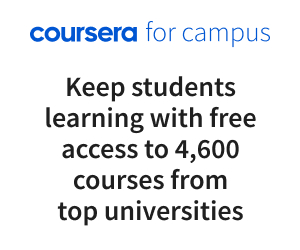Students are increasingly demanding practical skills alongside traditional academic pathways to ensure they leave university with the credentials required by employers
Webinar held in December 2021.
Student employability is a pressing issue for universities across North America, with skills-focused education and the creation of lifelong learners at its core. The implementation and delivery of this new model of teaching present many strategic challenges that institutions must overcome.
During a webinar held by Times Higher Education in partnership with Coursera for Campus, academics from across North America came together to discuss how institutions can use digital tools to prepare students for the world of work.
“We have an ‘engineering education enrichment’ – or e3 – initiative, that seeks to increase student employment and marketability,” said Sara Patricolo, programme manager for the college of engineering at New Mexico State University. “We invite students to pursue industry certification of their choosing, take entrepreneurship training and engage in a co-curricular learning opportunity that complements our classroom lectures and lab work. It’s about providing an opportunity for students to better themselves and make them more career-ready.”
“I have to complement students that already have their set courses but are exploring other opportunities with Coursera,” said Olivia Seppi, senior student programme coordinator at New Mexico State University. “They are dedicating their time and energy and then carrying that energy back into the classroom, which helps foster engagement in other students.”
The ability to combine traditional learning methods with digital tools seems to have led to a change in student behaviours, with many now demanding job-ready skills. “We take traditional IT classes but incorporate real-world technology with the help of vendors like Coursera,” explained Bill Rials, associate director and professor of practice for information technology at Tulane University. “Because the IT and cybersecurity field is always changing, we try to keep up by blending a traditional academic approach with critical thinking and real-world skills. We call it ‘prac-ademia’.”
Of course, as institutions start to offer in-person teaching again, they will be tasked with balancing traditional and digital modes of learning. “We are currently pursuing a hybrid model of teaching,” Lameck Osinde, lecturer in information systems at the Ivey Business School, Western University, commented. “In the past, we were purely online...but we realised that there was a gap between what the industry demands and there was [also] a business skills gap...The firms and entrepreneurs require students with the hands-on experience before they can get into the job market. So, we got into partnership with Coursera and grouped multiple courses to allow students to gain access to supplementary material that they can study at their own pace.”
Skills-based education often takes an interdisciplinary approach, and this is something that many students are now requesting to ensure they are ready for the modern world of work. “When we talk to our young engineers, we stress the importance of becoming a lifelong learner,” Patricolo noted. “It’s good for students to learn this habit as early as possible.”
“We’ve created a curated set of Coursera classes that lets students expose themselves to new opportunities,” Rials said. “These focus on business skills – like teamwork and communication – that increase students’ professional capacity.”
“We also allow our students to access other Coursera modules so those with additional interests can complete them,” Osinde noted. “This has increased engagement even outside of term time.”
Institutions are also engaging with employers to ensure they are offering job-ready skills. “We have an excellent relationship with employers that visit our campus,” Patricolo explained. “We hear from employers directly regarding the types of skills they need. They want to build that collaboration so students are ready to be employed and hit the ground running.”
“It’s true that the employment landscape is changing,” Osinde acknowledged. “That’s why we try to put our students in touch with local businesses and we invite business leaders into our classrooms.”
Taking traditional learning materials on board, engaging with industry leaders and accessing supplementary material online can create a busy schedule for students. “Balancing workloads is definitely a challenge,” Seppi admitted. “It’s important to avoid burnout. We don’t set deadlines and we communicate that if students can’t take up an opportunity right away, it will still be there in the future. That flexibility goes a long way to reducing the burden.”
The panel:
- Alistair Lawrence, special projects editor, Times Higher Education (chair)
- Lameck Osinde, lecturer in information systems, Ivey Business School, Western University
- Sara Patricolo, programme manager, college of engineering, New Mexico State University
- Bill Rials, associate director and professor of practice, information technology, Tulane University
- Olivia Seppi, senior student programme coordinator, New Mexico State University
Watch the webinar on demand above or on the THE Connect YouTube channel.
Find out more about Coursera for Campus.










































































